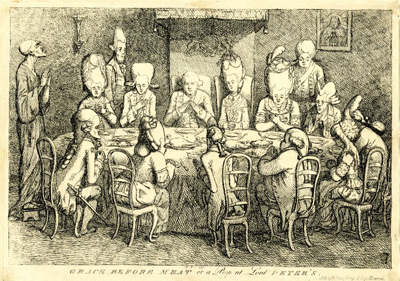Grace Before Meat...
In August of 1778, the Papist Act or Catholic Relief Bill passed both houses of Parliament relaxing some of the rules that had long been prejudicial to Catholics so that "all denominations should enjoy the blessings of our free constitution, and should be bound to each other by mutual interest and mutual affection."
As a gesture of support for this new and more enlightened attitude towards Catholics, King George and Queen Charlotte accepted the invitation of the Catholic Lord Petre to stay at his home at Thorndon Hall while on their way to a grand review of troops at Warley Common. It was the first time a British Sovereign had visited a Catholic noblemen since the Hanoverian succession.

© Trustees of the British Museum
Not everyone was happy with this development, however. In a letter of May 21, 1778, Horace Walpole complained that he soon expected "to see Capuchins tramping about and Jesuits in high places." And it was indeed the passage of the Catholic Relief Act that prompted George Gordon to lead Protestant associations in increasingly acrimonious protests against the act and ultimately to the Gordon Riots.
Like Walpole and many other loyal Protestants, Gillray was deeply suspicious of Catholics, and saw any concessions to them as a slippery slope towards Papacy. Here, therefore, he envisions the King and Queen in a room at Lord Petre's with a crucifix and a portrait of the Virgin Mary on the wall already participating in Catholic rituals as an ascetic-looking monk leads them in prayer. It is probably no accident that Gillray also shows twelve people seated around the table attending this last supper.
In fact, contemporary accounts make it clear that Gillray's portrayal is entirely constructed for satiric effect. The Morning Post records that at
five o'clock their majesties sat down to dinner at separate tables covered with every delicacy the season could produce. Lady Petre, Lady Effingham etc. etc. had the honour to dine with the Queen; and Lord Petre and the General Officers with his Majesty. In the evening they were entertained with a concert, of which several of the Nobility and Gentry of the County of Essex had the honour to partake.
Grace Before Meat... is sometimes regarded as the first satire that Gillray produced. If so it is an ambitious first effort. Gillray's arrangement of the fifteen figures around the oval table is nicely balanced with the royal canopy appropriately flanked by the two religious objects. But the portraiture is crude and the etching skill still rudimentary. Like other prints dating the 1770's, this print is strongly influenced by John Hamilton Mortimer.
Sources and Reading
- Commentary on Grace Before Meat. . .from the British Museum.
- Draper Hill, Mr. Gillray The Caricaturist, 1965, Pl. 27
- Wright and Evans, Historical and Descriptive Account of the Caricatures of James Gillray, 1851, #368
Comments & Corrections
NOTE: Comments and/or corrections are always appreciated. To make that easier, I have included a form below that you can use. I promise never to share any of the info provided without your express permission.
Last Modified: February 11 2025
© 2025 Jim Sherry. All rights reserved.